
It was with great enthusiasm that the Rouge et Noir discovered their new work tool just over a month ago. Fifteen months after the first sod was turned, it is a brand new structure, perfectly integrated into its landscape, spacious, modern and functional, which stands on almost 2,500 m2. « It takes the club into another dimension. It's got everything you need to work well. It's a beautiful training centre, very functional, very professional,’ says Arnaud Kalimuendo. ‘There aren't many clubs in France that can match it now. Stade Rennais has turned a corner. There have always been some very good players at Rennes. If, on top of that, the infrastructure is there, it's good for progression.
Unity at the heart of the project
Roazhon Park, where the artists perform. The Henri Guérin training centre is the rehearsal space, where the routines are practised throughout the week. Although it has undergone improvements over time, the old centre, which was nearly 25 years old, no longer met the demands of the very highest level. ‘Stade Rennais needed to improve its infrastructure in the balneotherapy, physiotherapy and body-building areas, as well as the communal and medical areas,’ explains Pierre Juhel, Stadium Manager and Director of Security at SRFC, who was in charge of the project. ‘It's not just a new changing room, but a facility where we spend a lot of time, where we build up our muscles, eat, take care of ourselves and analyse our matches,‘ adds Kali’.

Piv2 also represents the unity sought between the professionals, the Academy and the administrative staff. Once the first part of the project is completed, work will continue for a further 18 months. ‘The idea is to improve performance but also cohesion, with common areas that we didn't have before, such as a company restaurant,’ explains Pierre Juhel.
High-quality grass
In addition to the walls, substantial work has also been carried out on the surfaces where the players' boots are worn on a daily basis. ‘All the pitches at the centre, both the professional and academy sections, are now fibre-reinforced,’ continues Pierre Juhel. In other words, the best technology available, which can be found in virtually all Ligue 1 stadiums. Here, the aim is to improve the quality of training and reduce injuries. ‘Seeing pitches like this is exceptional in France. The Henri Guérin training centre now boasts seven regulation-sized pitches (including a latest-generation artificial pitch), half a goalkeeper pitch and half a synthetic pitch.
To better identify this reorganisation of the site and pitches, and to give meaning to SRFC's DNA, five Legends of the training centre now lend their names to the Academy pitches. Pierrick Hiard, Sylvain Wiltord, Yoann Gourcuff, Ousmane Dembélé and Eduardo Camavinga, illustrious players trained at Stade Rennais F.C. and all of whom have played for the French national team.

A site in harmony with its natural environment
Sublimating the green setting and respecting the flora and fauna were the watchwords of the project. Financed in its entirety by the club's shareholders, the project has been the focus of a great deal of attention and questioning in terms of respect for the environment, resource management and the ecological footprint, with the aim of making it a benchmark on the continent. Soil surveys, impact studies, choice of appropriate materials, construction techniques, preservation of species and wetlands, green roofs, water management and treatment, preference for local companies... Everything has been studied and thought through to make it an example. « This Piv2 has been intelligently designed » rsays Pierre Juhel. In line with the problems of our modern society. ‘We rebuilt on the old sites to avoid artificialising other plots of land. In terms of integration into the landscape, we opted for burnt wood, to create a natural facade for the buildings,’ reminiscent of the “Gwenn ha Du” or the Breton slate colour. The result is a majestic building that blends in without imposing, and is in no way ostentatious. ‘We're very proud of what the club has put together with the engineers, architects and landscapers. In harmony with the Breton bocage.
Water, a central element
Water management is one of the major innovations of this Piv2: ‘We have very high ambitions in this area and are investing heavily’. The construction of a 4,000m3 storage basin under the new artificial turf pitch will allow ‘drainage water to be reused for watering and drastically reduce our consumption of drinking water from the general network. What's more, we now have a system for recovering grey water’. For example, waste water from showers is used to supply the toilets. SRFC has gone even further with the help of technology. ‘Our teams will be able to use data to make more scientific use of water, such as measuring the moisture content of the soil on each pitch so that they can be watered with precision, making sure that they don't over-water,’ just what the pitch needs. Also under consideration is a project to reuse and treat water from the Beaurade wastewater treatment plant, just a stone's throw away.

Built on the current Piverdière site, more specifically the former players' car park, this large-scale project mobilised up to 80 people a day. In all, the project involved 300 people from all trades. ‘We must congratulate and thank everyone working on this project. The result is remarkable. It's up to us to take advantage of this new dynamic for the club to make it even more positive,’ says Arnaud Kalimuendo.
While the players and employees continued to work, the challenge was to coordinate the businesses - the overwhelming majority of which are local - on a site that was already in full swing. ‘That was one of the big challenges. The people working here fully understood our constraints and were able to demonstrate professionalism and discretion. They are very proud to be working on this project, which is out of the ordinary for them, in support of a club they support,’ adds Pierre Juhel. These men and women also had to deal with capricious weather conditions throughout 2024. The waterproofing tests were largely validated,’ laughs the project manager, ’but the schedules were respected at La Piverdière, and the quality of the work was never compromised.
Because rain is not going to stop the Bretons from brightening up their horizon.
Stade Rennais F.C. would like to thank the architects NeM, FM Ingénierie and Vincent Piofret for the high quality of their work.







































